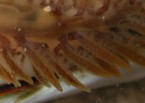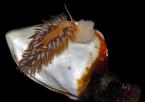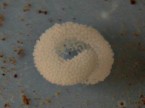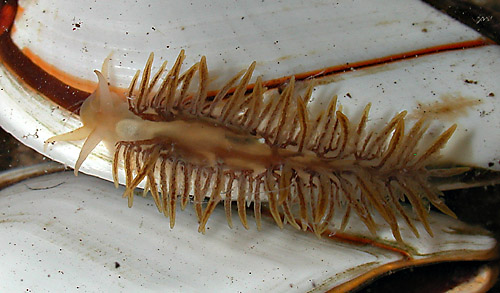_______________
Additional Photos

head

cerata detail

dark

egg mass
_______________
GALLERY

|
Fiona pinnata (Eschscholtz, 1831)

Maximum size: 20 mm.
Identification:
This
elongate
aeolid
appears
almost hairy due to the varying
length and random arrangement of its cerata. The body is
translucent-cream with branches of the digestive gland visible
through the notum and cerata as dark bands. Depending on the food
source, the bands may range from
gold to brown to deep blue. Unique to this species is an undulating
membrane along the posterior edge of each ceras. The head is rounded
and the rhinophores and cephalic tentacles are smooth and tapered.
Natural history:
Fiona pinnata is
commonly found on floating debris (such as wood, plastic and
glass balls) to which gooseneck barnacles of the genus Lepas are attached. They
cling tenaciously to their substrate and feed on the barnacles which they eat by penetrating
the stalk and
consuming the inner tissue. They also inhabit and feed on the
chondrophore Velella vallela,
consuming both the float and polyps. However, they do not store
the
nematocysts. Holleman (1972) reported a remarkably short life cycle for
this
species--maturing, mating and laying eggs within a month. This is
advantageous when a food resource is often small or isolated, as is the
case with barnacles growing on floating objects. By the time the food
is exhausted, the nudibranchs have
already reproduced and their larvae are "seeking" new
prey. Their egg masses can often be seen attached to the
floating debris near the animals. They are tightly coiled,
white to cream, barrel-shaped spirals of about 1-1.5 whorls with a
diameter and height of up to 3 mm. The masses are anchored by short
stalks of hardened mucus and may swell noticeably and become a
darker
cream as the eggs develop. A mass laid in a dish hatched in about
three days.
Distribution:
Big Island, Maui, Oahu, Kauai and French Frigate Shoals: cosmopolitan.
Taxonomic notes: The family Fionidae was formerly used only for this species. The name means feathered.
Photo: CP: 20
mm; found on a beached laundry basket covered with Lepas spp: Hekili Point, Maui;
April 6, 2004.
Observations and comments:
Note
1: ( )
|
|





